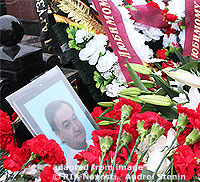Bringing out the dead: Why Sergei Magnitsky’s story remains relevant for the arts

(Moscow News – themoscownews.com – Natalia Antonova – Nov. 26, 2012)
Let’s get one thing out of the way first I am married to one of the actors starring in “One hour and eighteen minutes,” a documentary play about the death of lawyer Sergei Magnitsky.
And I am not here to talk to you about the quality of the play, which recently premiered in an updated format at Moscow’s Teatr.doc. Rather, I want to talk to you about why Magnitsky’s story, and stories like it (there is a fair number of them out there, unfortunately), are relevant for the theater world.
There is a never-ending discussion at Moscow theaters about what actually constitutes “art.” It gets pretty heated at times. “Pah! Magnitsky!” people say. “That’s not art! That’s politics! Stop polluting the ambiance with that nonsense!”
And yet the story itself is about as dramatic as you can get. In fact, it’s even frightening how scripted it appears, as if a talented screenwriter one day decided to bring to life all of the terrors of the judicial system. Three years after Magnitsky’s death in custody, his trial is ongoing. His mother has been asked to attend court hearings as his “representative,” and to sit in the little cage that is reserved for defendants in court. Many of the people implicated in his demise continue to earn their keep as judges and investigators, and some have even been promoted.
And what about the money? Before he was imprisoned, Magnitsky had allegedly exposed an enormous tax fraud scheme that had targeted no less than the government’s own coffers. Whatever you think of his employer, Hermitage Capital, you have to wonder just where that money which Magnitsky was in turn accused of stealing from the government on behalf of his employer actually ended up. The thing is, we don’t know for sure. Not yet, anyway.
The Magnitsky case is a Greek tragedy, a detective story and a Kafka-esque nightmare all rolled into one. Art, you say? The greatest artists of all ages would have trouble coming up with such a dark narrative.
The latest chapter in this saga is the Sergei Magnitsky Rule of Law Accountability Act, which is making its way through the U.S. Congress. If it is passed, those people implicated in the death would face visa and banking restrictions in the United States. But curiously enough, just how one gets to be included on the list is the source of some speculation. Is it possible for innocent people to be mistakenly included? We are going to have to stay tuned.
Of course, all of the controversy and hype can at times conceal the pure horror of what happened to Magnitsky. According to his mother, he believed that justice would prevail. She says he knew he was innocent, and that’s why he refused to cooperate with the investigators, who then unleashed the full might of their (seriously unchecked) powers of persuasion upon him. Denied basic medical care, he died an extremely slow and painful death, and there are allegations that he was “helped” in his dying by shadowy figures who needed to make him go away for good.
A civil law specialist, Magnitsky is a different kind of tragic hero: a man who wore a suit to work, a married father of two, dead at age 37. He didn’t ride a horse into battle like Joan of Arc did; he was dealing with tax returns. And yet he continues to haunt the landscape, the unanswered questions multiplying.
In this light, it’s wise to remember that the tragic figures of our days are often aesthetically muted: bundled up and muzzled like the detainees remaining at Guantanamo Bay, or else caught in a fleeting frame as they plunge from the burning World Trade Center, tiny dots of life that contain loved ones, daughters and sons, seconds from impact.
Every age has trouble accepting its new tragic heroes, because they remind us too much of ourselves. They remind us of the danger and peril just beyond our immediate field of vision. But that doesn’t make them any less worthy of our consideration.
